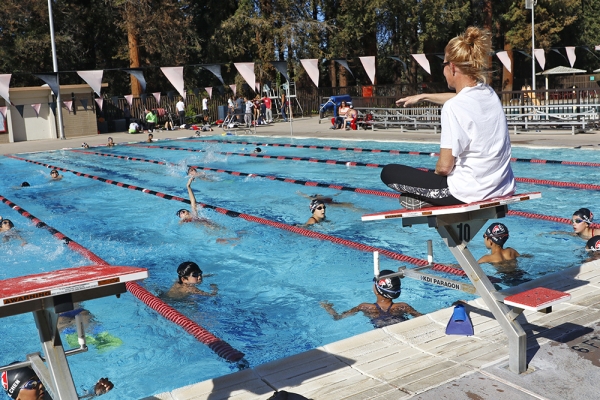For a sneak peek at Palo Alto's changing demographics look no further than the shimmering lanes at Rinconada Pool.
Every Monday, Wednesday and Friday morning, dozens of seniors from the pool's U.S. Masters Swim Club come to condition and train for upcoming races. On other mornings, the pool is dedicated to lap swimmers, some of whom have been coming for decades.
But as afternoon arrives, Rinconada becomes a magnet the city's bustling youth aquatics program, which has more participants than all of Palo Alto's youth and adult sports camps put together. In each of the past two years, the Community Services Department has had to do emergency hiring to meet the demand. Jazmin LeBlanc, a senior manager, noted last November that half of the youth swim lessons last year were full or had waiting lists.
This January, the City Council agreed to outsource the youth lessons to a private company, which would serve roughly double the number of children, from 5,500 to about 11,000 -- a move aimed, in part, at more efficiently using a prized community asset. But it would also require different types of pool users to share the lanes. For swimmers like Richard Hermance, and many like him, this isn't necessarily good news.
Hermance, a Rinconada regular for the past 35 years, was one of dozens of swimmers who attended a Parks and Recreation Commission meeting last November to express concerns about the new plan. Lap swimming, he said, "needs to be a dedicated activity using all of the lanes to best meet the needs of working people."
Gwen Fisher, also a lap swimmer, also voiced worries.
"Think about someone who says to a football team, a baseball team and a soccer team: 'You're all going to use the same turf for your practice.' ... It doesn't work," Fisher said. "Same with sharing of our pool."
Yet with the city's population growing and spurring additional demand for recreation services, sharing is becoming an increasingly central part of the city's recreation strategy, whether you're talking about swimming lanes, playing fields or neighborhood parks.
Part of this has to do with demographics. The city's new Parks, Trails, Natural Open Space and Recreation Plan notes that Palo Alto's populations of seniors and children have grown since 1980 and now make up 17 percent and 23 percent, respectively, of the city's total residents. By 2030, one half of all Palo Alto residents is expected to be 55 years or older, the plan states.
At the same time, the plan notes, these age groups "are, anecdotally, high users of parks and recreation facilities and services in Palo Alto."
The master plan thus places a premium on maximizing the use of existing facilities and ensuring that new ones are flexible enough to accommodate multiple needs. Doing so means, among other things, installing lighting at parks to allow usage until dusk; finding ways to "mitigate conflicts" between bicyclists, equestrians and hikers on the trails of the Pearson-Arastradero Preserve; and designing playing fields to accommodate "local organized sports and casual users with areas large enough for practice or play."
Already, the city has attempted to navigate conflicting demands for space by revising its field-use policy, which had traditionally given exclusive priority to "non-select" groups (those that don't require tryouts) like the soccer organization, Palo Alto AYSO. After hearing concerns from other athletic groups, the city in 2013 changed its policy so that the main criterion for priority is the proportion of users who are Palo Alto residents. The new policy also includes a "round robin" system for allocating field use, though after hearing from the AYSO, the city agreed to allow competing groups to negotiate among themselves, thus obviating the need for a round robin.
Sometimes, the sharing occurs organically, with little city involvement. Consider pickleball, a tennis-like game with paddles and a small net. Dozens of seniors flock on the weekends to Mitchell Park tennis courts, which they restripe with temporary tape to suit their purposes.
As the sport grows in popularity, the park's capacity to accommodate both users will be tested. In preparation of the new master plan, city staff has been fielding requests from pickleball players for dedicated courts. Community Services Director Rob de Geus said the city will do what it can to meet their needs.
"Given that particular sport and how it's increasing in popularity across our region and beyond, and given our demographics, we need to make sure we have some pickleball courts," de Geus said in an interview with the Weekly.
Related content:



Comments